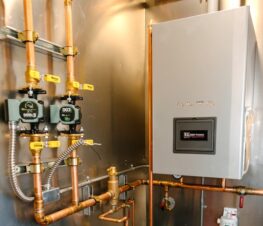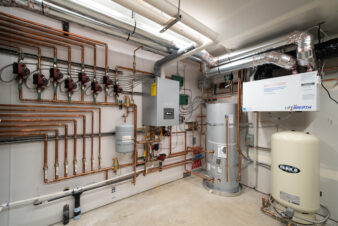by plumbing expert Rich Grimes
What is the best domestic water piping system? Great question with no easy answer! It is truly a matter of preference and each system has its own inherent benefits. Let’s look at some of the more common materials that are used. Most products up to 2″ size are Copper Tube Size (CTS) but alternative methods can be Iron Pipe Size (IPS). The key is that products must be NSF-61 listed for potable water.
COPPER is one of the oldest and most reliable methods for domestic water supplies. It has become an expensive metal over time so that opens the door for alternative piping systems. It has various benefits such as strength, corrosion and temperature resistance, longevity and its natural ability to inhibit bacterial growth. It uses full-flow fittings (tube fits inside of fitting) that are typically soldered connections.
CPVC is another CTS piping material that is often used for domestic water. It is a harder version of PVC that can withstand temperatures up to 180F. It employs a full-flow fitting that is usually socket-welded with solvent-cement. It is non-metallic so it can answer some issues that may arise with copper (dielectric corrosion, etc.) but it is a polymer that can degrade when exposed to petroleum and other chemical products. While it is mostly sold up to 2″ size in CTS, it also is sold as a Schedule 40 or 80 IPS potable water distribution system.
PEX is another polymer that is rated for domestic potable water. It is also CTS size tubing with an internal fitting. It uses a crimp-ring or clamp around the tubing and fitting to create a joint. Crimp and clamp tools are an integral part of the system for making a watertight connection. PEX is a flexible, labor-saving product that is produced in long coils. Long runs can be accomplished with fewer fittings or no fittings under slab.
There are several other polymers that have a NSF-61 rating, typically in IPS and used on domestic water lines over 2″ size. These are competing with large diameter metal piping systems for CW and HW mains of copper or SS.
One variable that must considered is the fittings to be used and the joining method. Today there are a variety of specialty fittings that can greatly reduce installation time and labor. While these fittings and joining methods may have a higher fitting cost, they can ultimately save money when considering the total installed cost. Press fittings have become popular because they greatly reduce labor and allow for a viable copper joint. Solvent welded CPVC can save labor over a soldered copper connection but there are solvent cement costs and joint curing times that must be considered. PEX fittings cost more that CPVC fittings but their clamping methods reduce labor and there is no waiting for curing. A mechanically-extracted tee on copper can eliminate most fitting costs and greatly reduce labor, but they require brazed joints and the cost of the tool system comes into play. Push-joint fittings eliminate tool costs, soldering or solvent-welding, down time, and labor but the fitting cost is higher…
It is probably best to look at items like project location, type of service, local environment, operating temperatures, ambient temperatures, tubing heat transfer, etc. to select the right piping or tubing for a project. Most contractors will utilize several if not all of these methods in their business, but typically standardize on a preferred pipe and fitting method. There is no single piping system that can meet every need and each system has its own benefits and best application. As well, each system is not bulletproof and can be susceptible to the surrounding environment, chemicals or various stresses that can cause a failure. Most products today have very high pressure ratings and it is proven that most piping failures are due to improper preparation and installation. If the manufacturer’s instructions are followed, any of these piping methods can provide a good domestic water distribution system that will last for years and years.




Join the conversation: